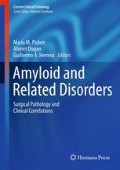Abstract
Over 25 different proteins have been shown to cause amyloidosis [1]. Most important amyloid types that cause morbidity and mortality are systemic in nature and include SAA (so-called secondary or AA-type), TTR (so-called ATTR, senile or hereditary), and immunoglobulin kappa (IGK) or lambda light chains (IGL) (so-called primary or AL-type) [2]. These four proteins account for over 85% of systemic amyloidosis. The current management of amyloidosis relies on treatment of the underlying etiology often by high-risk aggressive treatment modalities such as high-dose chemotherapy and peripheral blood autologous stem cell transplantation (for AL-type amyloidosis) [3] or liver transplantation (for hereditary TTR-type amyloidosis) [4, 5]. Given the critical nature of these management decisions, accurate subtyping of amyloid deposits in routine clinical biopsy specimens is of paramount importance.
Access this chapter
Tax calculation will be finalised at checkout
Purchases are for personal use only
References
Sipe JD, Benson MD, Buxbaum JN, et al. Amyloid fibril protein nomenclature: 2010 recommendations from the nomenclature committee of the International Society of Amyloidosis. Amyloid. 2010;17:101–4.
Merlini G, Bellotti V. Molecular mechanisms of amyloidosis. N Engl J Med. 2003;349:583–96.
Merlini G, Seldin DC, Gertz MA. Amyloidosis: pathogenesis and new therapeutic options. J Clin Oncol. 2011;29:1924–33.
Holmgren G, Ericzon BG, Groth CG, et al. Clinical improvement and amyloid regression after liver transplantation in hereditary transthyretin amyloidosis. Lancet. 1993;341:1113–6.
Stangou AJ, Hawkins PN. Liver transplantation in transthyretin-related familial amyloid polyneuropathy. Curr Opin Neurol. 2004;17:615–20.
Howie AJ, Brewer DB, Howell D, Jones AP. Physical basis of colors seen in Congo red-stained amyloid in polarized light. Lab Invest. 2008;88:232–42.
Picken MM, Herrera GA. The burden of “sticky” amyloid: typing challenges. Arch Pathol Lab Med. 2007;131:850–1.
Solomon A, Murphy CL, Westermark P. Unreliability of immunohistochemistry for typing amyloid deposits. Arch Pathol Lab Med. 2008;132:14.
Picken MM. New insights into systemic amyloidosis: the importance of diagnosis of specific type. Curr Opin Nephrol Hypertens. 2007;16:196–203.
Murphy CL, Eulitz M, Hrncic R, et al. Chemical typing of amyloid protein contained in formalin-fixed paraffin-embedded biopsy specimens. Am J Clin Pathol. 2001;116:135–42.
Murphy CL, Wang S, Williams T, Weiss DT, Solomon A. Characterization of systemic amyloid deposits by mass spectrometry. Methods Enzymol. 2006;412:48–62.
Kaplan B, Martin BM, Livneh A, Pras M, Gallo GR. Biochemical subtyping of amyloid in formalin-fixed tissue samples confirms and supplements immunohistologic data. Am J Clin Pathol. 2004;121:794–800.
Rodriguez FJ, Gamez JD, Vrana JA, et al. Immunoglobulin derived depositions in the nervous system: novel mass spectrometry application for protein characterization in formalin-fixed tissues. Lab Invest. 2008;88:1024–37.
Vrana JA, Gamez JD, Madden BJ, Theis JD, Bergen 3rd HR, Dogan A. Classification of amyloidosis by laser microdissection and mass spectrometry-based proteomic analysis in clinical biopsy specimens. Blood. 2009;114:4957–9.
Hood BL, Darfler MM, Guiel TG, et al. Proteomic analysis of formalin-fixed prostate cancer tissue. Mol Cell Proteomics. 2005;4:1741–53.
Prieto DA, Hood BL, Darfler MM, et al. Liquid Tissue: proteomic profiling of formalin-fixed tissues. Biotechniques. 2005;38(Suppl):32–5.
Palmer-Toy DE, Krastins B, Sarracino DA, Nadol Jr JB, Merchant SN. Efficient method for the proteomic analysis of fixed and embedded tissues. J Proteome Res. 2005;4:2404–11.
Guo T, Wang W, Rudnick PA, et al. Proteome analysis of microdissected formalin-fixed and paraffin-embedded tissue specimens. J Histochem Cytochem. 2007;55:763–72.
Vrana JA, Theis JD, Gamez JD, et al. Diagnosis and classification of systemic amyloidosis in abdominal subcutaneous fat aspiration specimens using mass spectrometry-based proteomics. Amyloid. 2010;17:55–6.
Sethi S, Theis JD, Leung N, et al. Mass spectrometry-based proteomic diagnosis of renal immunoglobulin heavy chain amyloidosis. Clin J Am Soc Nephrol. 2010;5:2180–7.
Dogan A, Theis JD, Vrana JA, et al. Clinical and pathological phenotype of leukocyte cell-derived chemotaxin-2 (LECT2) amyloidosis (ALECT2). Amyloid. 2010;17:69–70.
Klein CJ, Vrana JA, Theis JD, et al. Mass spectrometric-based proteomic analysis of amyloid neuropathy type in nerve tissue. Arch Neurol. 2011;68:195–9.
Miller DV, Dogan A, Sethi S. New-onset proteinuria with massive amorphous glomerular deposits. Am J Kidney Dis. 2010;55:749–54.
Lacy MQ, Theis JD, Vrana JA, et al. Lysozyme amyloidosis (ALys) affecting a family with a new variant of lysozyme gene (LYZ) and hereditary haemorrhagic telangiectasia. Amyloid. 2010;17:125.
Rowczenio D, Dogan A, Theis JD, et al. Amyloidogenicity and clinical phenotype associated with five novel mutations in apolipoprotein A-I. Am J Pathol. 2011;179(4):1978–87.
Dogan A, Vrana JA, Theis JD, Gamez JD, Kurtin PJ, Grogg KL. Mass spectrometry-based proteomic analysis of iatrogenic insulin-mediated amyloidosis (AIns). Amyloid. 2010;17:114.
Author information
Authors and Affiliations
Corresponding author
Editor information
Editors and Affiliations
Rights and permissions
Copyright information
© 2012 Springer Science+Businees Media, LLC
About this chapter
Cite this chapter
Dogan, A. (2012). Classification of Amyloidosis by Mass Spectrometry-Based Proteomics. In: Picken MD, PhD, FASN, M., Dogan, M.D., Ph.D., A., Herrera, M.D., G. (eds) Amyloid and Related Disorders. Current Clinical Pathology. Humana Press. https://doi.org/10.1007/978-1-60761-389-3_21
Download citation
DOI: https://doi.org/10.1007/978-1-60761-389-3_21
Published:
Publisher Name: Humana Press
Print ISBN: 978-1-60761-388-6
Online ISBN: 978-1-60761-389-3
eBook Packages: MedicineMedicine (R0)

